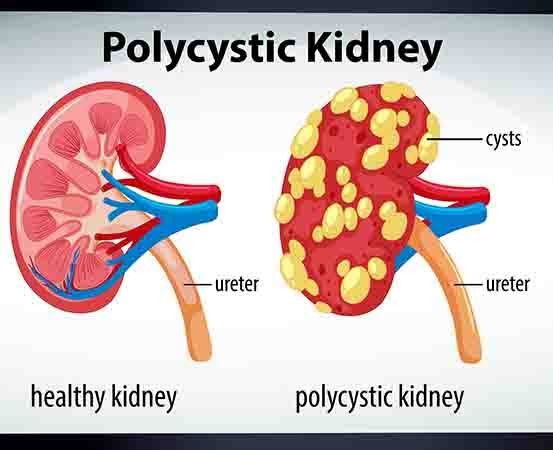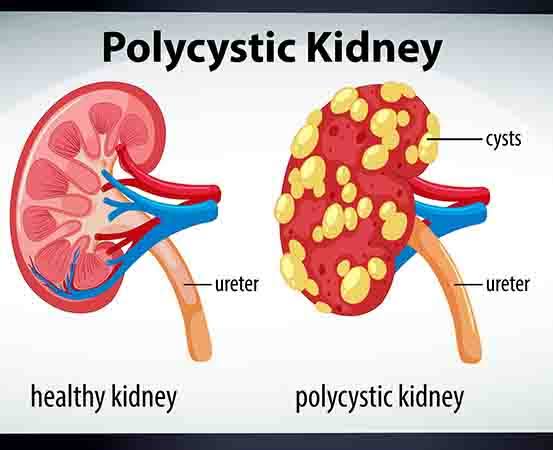Sandeep Dhand Ludhiana
Nutritionist And Health Educator
Polycystic Kidney Disease (PKD) is a genetic disorder that leads to the development of numerous fluid-filled cysts in the kidneys. These cysts cause the kidneys to enlarge and lose function over time. PKD is a progressive disease that can lead to complications, including kidney failure. It affects both men and women and is one of the most common genetic disorders, impacting millions worldwide. Below is an in-depth explanation of PKD, its types, symptoms, complications, diagnosis, and management.

Types of Polycystic Kidney Disease
PKD is broadly categorized into two types based on its inheritance pattern and onset:
- Autosomal Dominant Polycystic Kidney Disease (ADPKD)
Prevalence: ADPKD is the most common form, accounting for about 90% of PKD cases.
Inheritance: It is autosomal dominant, meaning that an affected individual has a 50% chance of passing the disease to their children.
Onset: Symptoms usually appear between 30 and 40 years of age, though cysts can develop earlier.
Genetic Cause: Mutations in the PKD1 or PKD2 genes cause ADPKD. PKD1 mutations lead to more severe disease progression compared to PKD2 mutations.
- Autosomal Recessive Polycystic Kidney Disease (ARPKD)
Prevalence: ARPKD is much rarer and more severe.
Inheritance: It is autosomal recessive, requiring both parents to pass on the defective gene for the disease to manifest in their child.
Onset: ARPKD is usually diagnosed in infancy or early childhood, and in severe cases, it can be life-threatening at birth.
Genetic Cause: ARPKD is caused by mutations in the PKHD1 gene, which affects the fibrocystin protein responsible for kidney and liver development.
Symptoms of Polycystic Kidney Disease
The symptoms of PKD vary depending on its type and stage of progression:
- Common Symptoms in ADPKD:
High Blood Pressure: This is often the first noticeable symptom and can occur even before kidney function declines.
Back or Side Pain: Caused by enlarged kidneys or cyst rupture.
Blood in Urine: Due to ruptured cysts or kidney stones.
Frequent Urinary Tract Infections (UTIs): Especially in the kidneys.
Abdominal Swelling: Due to the enlarged kidneys.
Kidney Stones: Occur in some individuals, causing additional pain.
- Symptoms in ARPKD:
Enlarged kidneys detectable at birth.
Respiratory issues in newborns due to underdeveloped lungs.
Liver fibrosis (scarring) leading to complications in childhood.
Complications of PKD
PKD can lead to several severe complications if left unmanaged:
- Kidney Failure:
Over time, cyst growth reduces kidney function, leading to end-stage renal disease (ESRD).
Patients with ESRD may require dialysis or a kidney transplant to survive.
- Liver Cysts:
Many individuals with PKD develop liver cysts, though these are often less problematic than kidney cysts.
- High Blood Pressure:
Chronic high blood pressure damages blood vessels in the kidneys and other organs.
- Aneurysms:
Increased risk of brain aneurysms, particularly in patients with a family history of the condition.
- Heart Issues:
Mitral valve prolapse or other heart valve abnormalities are more common in PKD patients.
- Pregnancy Complications:
Women with PKD and high blood pressure may experience complications such as preeclampsia.
- Hernias and Diverticulosis:
Increased pressure from kidney enlargement can lead to abdominal hernias or diverticula in the colon.
Diagnosis of PKD
Timely diagnosis is crucial to manage PKD and slow its progression. The following methods are commonly used:
- Imaging Tests:
Ultrasound: The most common diagnostic tool to detect cysts in the kidneys.
CT or MRI: Used for detailed imaging to assess cyst size and number, especially in early-stage disease.
- Genetic Testing:
Confirms the diagnosis, particularly in families with a history of PKD.
Useful for detecting mutations in PKD1, PKD2, or PKHD1 genes.
- Blood and Urine Tests:
Help monitor kidney function by assessing creatinine levels and detecting blood or protein in the urine.
Treatment and Management

Currently, there is no cure for PKD. Treatment focuses on managing symptoms, slowing disease progression, and preventing complications.
- Lifestyle Modifications:
Healthy Diet: Follow a diet low in salt, fat, and protein to reduce kidney strain.
Hydration: Drinking plenty of water may help prevent kidney stones.
Exercise: Maintain a healthy weight through regular, moderate physical activity.
Avoid Smoking and Alcohol: These can accelerate kidney damage.
- Medications:
Blood Pressure Control: Use ACE inhibitors or ARBs to manage hypertension.
Tolvaptan: An FDA-approved drug for ADPKD to slow cyst growth and preserve kidney function.
Pain Management: Over-the-counter painkillers like acetaminophen (avoid NSAIDs as they can harm the kidneys).
- Invasive Treatments:
Draining Cysts: Performed to relieve pain or infection.
Surgical Removal of Kidneys: In severe cases with extremely enlarged kidneys.
- Advanced Treatments for ESRD:
Dialysis: Used to filter waste and fluids from the blood when kidneys fail.
Kidney Transplant: The only definitive treatment for ESRD.
Preventive Measures and Monitoring
Since PKD is genetic, prevention is not possible, but early detection and management can slow disease progression:
Regular monitoring of blood pressure and kidney function.
Avoid medications that can harm the kidneys (e.g., NSAIDs).
Family counseling and genetic testing to understand risks for future generations.
Conclusion
Polycystic Kidney Disease is a lifelong condition that requires proactive management and lifestyle changes. With advancements in medical treatments like Tolvaptan and improved dialysis techniques, patients can manage symptoms and maintain a good quality of life. Early diagnosis and regular monitoring are crucial in preventing complications such as kidney failure and cardiovascular issues. Collaboration with healthcare providers, adherence to treatment plans, and informed decision-making are essential for individuals living with PKD.